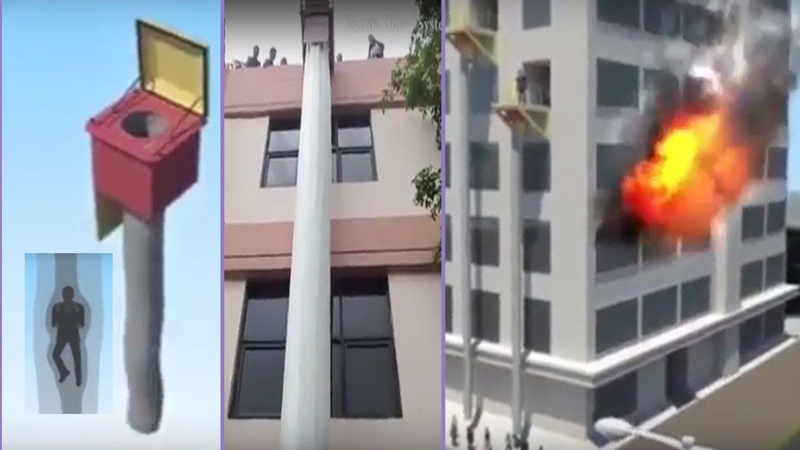
Todos estamos de acuerdo en que los sistemas de salvamento son importantes durante la vida en situaciones críticas y de emergencia. Tener medidas que aseguren que se salven al máximo las vidas en caso de un desastre es el principal objetivo de las medidas para salvar vidas. Un ejemplo de ello es el incendio de la Torre Grenfell, donde la 'política de quedarse quieto' del edificio de gran altura falló y las llamas masivas lo envolvieron. Idealmente, debería haber una forma de evacuación de emergencia que funcione de manera rápida y eficiente.
Por mucho que busquemos métodos de extinción de incendios como la ayuda del cuerpo de bomberos, rociadores y extintores de incendios, a veces tenemos que pensar en cómo preservar la vida humana antes de controlar los incendios. Existe la necesidad de sistemas de evacuación eficientes y efectivos que puedan evacuar a muchas personas de edificios de gran altura de una sola vez. Si bien se descartan los ascensores debido a problemas eléctricos obvios, una alternativa sería la escalera. Sin embargo, la evacuación por las escaleras puede requerir mucho tiempo.
Una descripción general de Verti-Scape
El Verti-Scape es un dispositivo que ayuda en la evacuación masiva y rápida de personas de estructuras altas. Cada rampa puede evacuar hasta 375 personas de una estructura elevada en un cuarto de hora.
Escape Chute Systems sugiere la utilización de una escalera estándar si es posible. Sin embargo, si la escalera está bloqueada o llena de humo, las rampas de escape son una alternativa rápida y eficiente.
La rampa de escape puede ser utilizada por personas con discapacidad. Además, la compañía afirma que después de un poco de capacitación, las personas con discapacidad visual están más que equipadas para usar el paracaídas. También es posible que una persona ingrese a la rampa y luego se coloque a una segunda persona lesionada sobre sus hombros para ayudar a la segunda persona a evacuar.
Cómo funciona
El conducto de escape se puede instalar en la mayoría de las estructuras y solo requiere una caída clara desde el punto de evacuación hasta el nivel del suelo. Se ejecuta en paralelo con el lado de la estructura desde el que se despliega y se puede utilizar inmediatamente después del despliegue. Mientras viaja por el conducto de escape, puede mirar hacia arriba y hacia abajo. No puede entrar humo en el conducto. Salir; sus pies harán contacto con el suelo, luego se agachará y sacará su cuerpo del paracaídas y se irá.
El Verti-Scape se fabrica a partir de tres tubos / conductos de tela completamente separados y claramente diferentes.
Cada tubo / tolva tiene su propia función que realizar, y solo cuando estos tres tubos / tolvas se ensamblan juntos se convierten en una tolva de escape.
La capa exterior del conducto de escape (gris oscuro en la imagen de arriba) está ahí para proteger a los usuarios de las llamas y el calor irradiado. Puede soportar una temperatura constante de entre 550 y 600 ° C y se funde a alrededor de 810 ° C.
Tenga en cuenta el espacio entre la capa exterior y la capa intermedia / de frenado, esto permite que el aire circule entre los dos tubos, evitando así la transferencia de calor.
La capa intermedia / de frenado (gris claro) es la capa que hace que el sistema funcione. Es un tubo elástico, que tiene aproximadamente 300 mm de diámetro en su forma descansada, pero tiene la capacidad de expandirse a 600 mm a medida que el evacuado viaja. A medida que el evacuado aplica presión hacia afuera desde el interior de la rampa, el evacuado reduce la velocidad y, a medida que libera la presión, aumenta la velocidad. El evacuado tiene el control total de la velocidad a la que descienden.
La rampa interior / de soporte (color beige en la foto) le da al sistema su fuerza para sostener el peso de todos los usuarios dentro de la rampa en cualquier momento. Esta capa tiene lazos cosidos en la parte superior, en la que se inserta un tubo laminado de acero inoxidable. A continuación, el dispositivo de despliegue mantiene la tubería en su lugar.
We all agree that life-saving systems are important during life critical and emergency situations. Having measures that ensure maximum lives are saved in case of a disaster is the main objective of life-saving measures. A case in point is of the Grenfell Tower fire, where the ‘stay put policy’ of the high-rise building failed, and massive flames engulfed it. Ideally, there should be a form of emergency evacuation that works fast and efficiently.
As much as we look up to fire-fighting methods such as help from the fire brigade, sprinklers and fire extinguishers, at times we have to think of how to preserve human life before getting fires under control. There is a need for efficient and effective evacuation systems that can evacuate many people from high-rise buildings in one go. While ruling out elevators because of obvious electrical issues, an alternative would be the staircase. However, evacuating through the staircase may require a lot of time.
An overview of the Verti-Scape
The Verti-Scape is a gadget, which helps in the mass and quick evacuation of individuals from high structures. Each chute can evacuate up to 375 people from an elevated structure in a quarter hour.
Escape Chute Systems suggest the utilization of standard staircase if possible. However, should the staircase be blocked or filled with smoke, escape chutes are a quick and efficient alternative.
The escape chute can be used by people with disabilities. Moreover, the company claims that after a little training, visually impaired individuals are more than equipped to use the chute. It is also possible for a person to enter the chute, and then have an injured second person placed upon their shoulders, to assist the second person to evacuate.
How it works
The Escape Chute can be installed onto most structures, and just requires a clear drop from the point of evacuation to the ground level. It runs parallel with the side of the structure from which it is deployed, and can be utilized promptly after deployment. As you travel through the escape chute, you can look up and down. No smoke can enter the chute. To exit; your feet will make contact with the ground, you then crouch and extract your body from the chute and leave.
The Verti-Scape is manufactured from three completely separate and distinctly different fabric tubes/chutes.
Each tube/chute has its own function to perform, and it is only when these three tubes/chutes are assembled together that they then become an Escape Chute.
The outer layer of the escape chute (dark grey in pic above) is there to protect the users from flame and radiated heat. It can withstand a constant temperature of between 550 & 600° C, and melts at around 810° C.
Note the gap between the outer layer and the middle/braking layer, this allows air to circulate between the two tubes, thus preventing heat transfer.
The middle/braking layer (light grey) is the layer that makes the system work. It is an elasticated tube, which is approximately 300mm in diameter in its rested form, but has the capability to expand to 600mm as the evacuee travels through. As the evacuee applies outward pressure from within the chute, the evacuee slow down, and as they release pressure, they speed up. The evacuee has full control of the speed at which they descend.
The inner/support chute (beige color in pic) gives the system its strength to hold the weight of all the users within the chute at any one time. This layer has loops stitched into the top, into which a stainless steel rolled pipe is inserted. The pipe is then held in place by the deployment device.

Startup
A startup or start-up is a company or project undertaken by an entrepreneur to seek, develop, and validate a scalable business model. While entrepreneurship refers to all new businesses, including self-employment and businesses that never intend to become registered, startups refer to new businesses that intend to grow large beyond the solo founder. At the beginning, startups face high uncertainty and have high rates of failure, but a minority of them do go on to be successful and influential. Some startups become unicorns; that is privately held startup companies valued at over US$1 billion.
Actions
Startups typically begin by a founder (solo-founder) or co-founders who have a way to solve a problem. The founder of a startup will begin market validation by problem interview, solution interview, and building a minimum viable product (MVP), i.e. a prototype, to develop and validate their business models. The startup process can take a long period of time (by some estimates, three years or longer), and hence sustaining effort is required. Over the long term, sustaining effort is especially challenging because of the high failure rates and uncertain outcomes. Having a business plan in place outlines what to do and how to plan and achieve an idea in the future. Typically, these plans outline the first 3 to 5 years of your business strategy.
Design principles
Models behind startups presenting as ventures are usually associated with design science. Design science uses design principles considered to be a coherent set of normative ideas and propositions to design and construct the company's backbone. For example, one of the initial design principles is "affordable loss".
- Log in to post comments